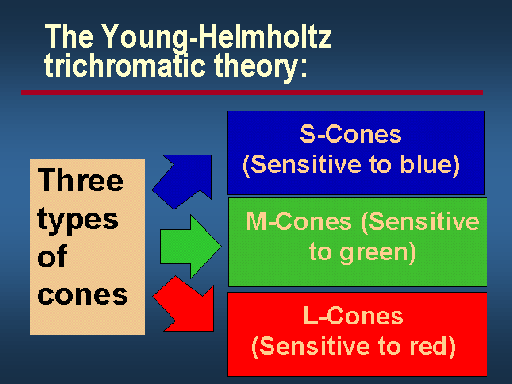|
|
|
|
|
|
|
|
|
|
|
|
|
|
|
|
|
|
|
|
|
|
|
|
|
|
|
|
|
|
|
|
|
|
|
|
|
|
|
|
Experiments, Discoveries, Honors
|
|
|
|
|
|
|
|
|
|
Although Thomas Young is famous for his double-split experiment, he made a variety of other discoveries that have been useful to this day.
His primary interest was sense perception. While he was in medical school, he discovered how the lens of the human eye changes shape to focus on objects at various distances. He pursued his interest of the human eye, and soon discovered the cause of astigmatism. Along with a colleague Hermann Ludwig Ferdinand von Helmholtz, they developed the Young-Helmholtz Trichromatic Theory. This is, that there are only three distinct types of cones in the retina, and each one was sensitive to a certain color, red, greed or blue. They also found that the cone receptor structure was what received and transmitted the information to the brain, when the eye captured a color.
|
|
|
|
|
|
|
|
|
|
|
 |
|
|
|
|
|
|
|
|
|
|
|
|
|
http://www.hsu.edu/faculty/langlet/lectures/senses/senses/sld009.htm |
|
|
|
|
|
|
|
|
|
|
|
Hermann Ludwig Ferdinand von Helmholtz
|
|
|
|
|
|
|
|
|
|
|
|
|
|
|
 |
|
|
|
|
|
|
|
|
|
|
|
|
|
http://www-gap.dcs.st-and.ac.uk/~history/PictDisplay/Helmholtz.html |
|
|
|
|
|
|
|
With his demonstration of the interference of light, Young used his wave theory to help explain the colors of thin films, like in soap bubbles, and relating color to wavelength. At a Bakerian Lecture in November 24, 1803, Taylor explained the formation of colored bands in soap films.
|
|
|
|
|
|
|
“When a film of soapy water is stretched over a wine glass, and placed in a vertical position, its upper edge becomes extremely thin, and appears nearly black, while the parts below are divided by horizontal lines into a series of colored bands…and when two glasses, one of which is slightly convex, are pressed together with some force, the plate of air between them exhibits the appearance of colored rings, beginning from a black sport at the center, and becoming narrower and narrower, as the curved figure of the glass causes the thickness of the plat of air to increase more and more rapidly.”
|
|
|
|
|
|
|
This established that there is a 180° change of phase when light is reflected from the surface of a denser medium. In 1817, he proposed that light waves were transverse rather than longitudinal. The difference is that transverse waves vibrate at right angles to the direction of travel, while longitudinal waves vibrate in the direction of travel. With this, polarization was explained.
Aside from his interest in the human eye and the inference of light, he also did various experiments pertaining to measuring the size of molecules, surface tension in liquids, and quantities of elasticity. Also, Young was the first scientist to give “energy” its scientific connotation, and in his honor a constant in the mathematical equation describing elasticity was named.
|
|
|
|
|
|
|
|
|
|
|
|
|
|
|
|
|
|
|
|
|
